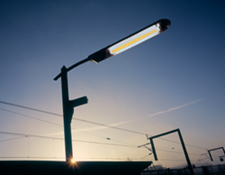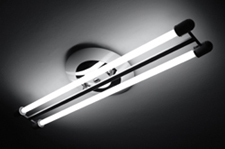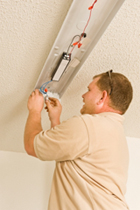|
Home: Outdoor Fluorescent Lighting
Outdoor Fluorescent Lighting For Your Home
You're in for a treat as you'll see that fluorescent lighting comes in many shapes and sizes. Lets look at how you can make your home's outdoors stand out and really take advantage of all that outdoor fluorescent lighting has to offer.
How Fluorescent Lamps Work
Fluroescent lamps come in many different shapes and sizes but they all work the same. They consist of a tubular bulb which houses an electrode at each end. Sealed inside the tube is a combination of mercury and argon gases. As voltage is supplied to the electrodes, the mercury and argon gases help to ignite the bulb. The bulb's walls are coated with fluorescent powders. The mercury and argon gasses help to ignite the lamp which in turn excites these powders causing visible light to be produced.
Advantages of Outdoor Fluorescent Lighting
Light Output Fluorescent lighting produces many more times the amount of light per watt compared to incandescent outdoor lamps. It is not uncommon for fluorescent lamps to produce three to five times the amount of light produced by incandescent lamps. Fluorescent lamps give off much less heat than traditional lamps. They are less likely to create problems due to heat damage and are less of a fire hazard.
Lifespan
Since fluorescent lamps have such a long lamp life, the maintenance necessary to replace the bulbs does not have to be performed as frequently, making them an excellent choice for hard to reach areas.
Energy Efficiency Fluorescent lighting is one of the most effecient types of lighting available today. Given the amount of light each lamp gives off, the amount of energy necessary to power such a lamp is minimal when compared to the amount of light they give off.
Compact Fluorescent Lamps (CFL) Compact fluorescent lamps come in handy. Some compact fluorescent lamps mimic the look and style of traditional incandescent lamps you may be familiar with. Some of the more commonly used outdoor lamps are the reflector and aperture lamps. These lamps look like their incandescent equivalents but are really compact fluorescent lamps within a traditional lamp's housing. Not only are they longer lasting and more energy efficient, but they provide fluorescent lighting with a controlled beamspread. Getting creative with your outdoor lighting scheme and saving energy can now be achieved.
Disadvantages of Outdoor Fluorescent Lighting
Lumen Output Outdoor fluorescent lighting tends to gradually lessen its lumen output (or light output) about halfway through its life cycle. Thats usually never a problem for most people because it's gradual decline goes mostly unnoticed.
Ballast Required
Some older fluorescent lights may produce an annoying humming sound. This is usually the case with older magnetic ballasts. These can easily be replaced with electric ballasts.
Directing Light Output Most fluorescent lamps due to their larger sizes make it difficult to direct light precisely. Although compact fluorescent lamps have made it easier to direct light output, they are still significantly larger than some of the smaller incandescent models.
Fluorescent Lighting Solutions For The Harsh Outdoors
The major challenge with fluorescent lighting is lighting them in very cold and windy environments. Lighting fluorescent lamps in colder temperatures makes it more difficult for the lamp to warm up and produce it's full light output. If it is extremely cold, they may not ignite at all. Because of their sensitivity to cold and windy environments, fluorescent lighting would have had limited outdoor use except that there are a number of solutions available to remidy this challenge.
Jacketed Lamps Jacketed lamps are named after the glass jacket that protects the fluorescent lamp from outside air. This helps to protect the fluorescent lamps from exposure to wind and aslo helps them to retain some of the heat thats produced by the lamps. This helps to keep the lamp operating at the proper temperature.
Low Temperature Ballast A low temperature ballast is a ballast designed for low temperature starting. These high output electronic ballasts can easily start your fluorescent lamps at temperatures as low as 0 degrees farenheight. 3 Inspiring Fluorescent Lighting Tips
Here are a some ideas you can use as inspiration:
Outdoor fluorescent lighting can be used to compliment your outdoor lighting environment and produce an abundance of light output without draining your wallet. No matter what you want to do for your outdoor lighting project, incorporating fluorescent lighting in your design can be a great idea.
|
FREE Newsletter Stay up-to-date with all the latest web updates, news, and outdoor lighting tips! Newsletter Form
|
|
|
|
Always consult with a licensed electrician before attempting any outdoor lighting work contained in this website.
Build your own site with Site Build It! | Copyright©2008 www.Creative-Outdoor-Lighting.com
Get your own custom template
 What types of fluorescent lighting are available for your outdoor environment?
What types of fluorescent lighting are available for your outdoor environment?
 Their lifespan ranges from 7,500 hours to 20,000 hours. A colossal difference when compared to the average life of 750 hours for an incandescent lamp.
Their lifespan ranges from 7,500 hours to 20,000 hours. A colossal difference when compared to the average life of 750 hours for an incandescent lamp. Fluorescent lighting requires a ballast. A ballast powers fluorescent lamps by controlling the amount of electricity supplied to the lamp. It also provides a jolt of extra power to ignite the lamp when it is turned on.
Fluorescent lighting requires a ballast. A ballast powers fluorescent lamps by controlling the amount of electricity supplied to the lamp. It also provides a jolt of extra power to ignite the lamp when it is turned on. 




